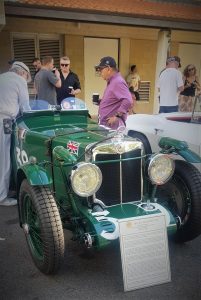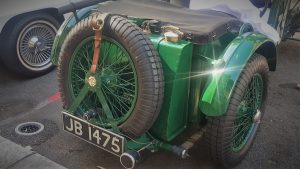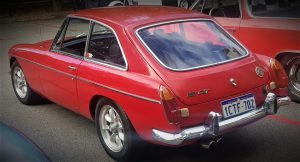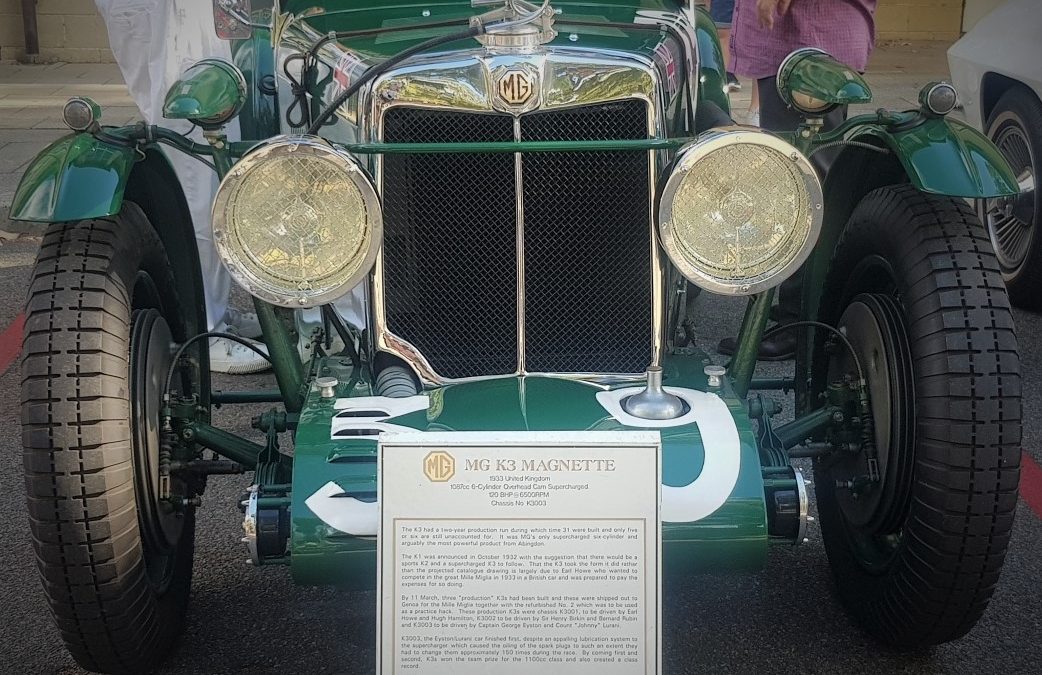MG K3:
This months event attracted a very diverse range of classic and vintage cars. By far the most impressive was this vintage MG K3, circa 1933. The still pics don’t really capture how magnificent this classic is. It was a show stopper. The crowd stopped and watched in wonder as this thing rumbled through the crowd, its driver in search of a place to park and display its magnificence. It is extremely rare, being 1 of only 31 ever built, and 1 of only 25 known remaining cars. What the pics do capture I hope is how beautifully this beast has been restored and presented for viewing. It was immaculate everywhere you look.

History of the K3:
MG K3 Magnette, 1933, United Kingdom, 1087cc 6-Cylinder Overhead Cam, Supercharged, 120BHP@6500RPM, Chassis No K3003.
The K3 had a wo-year production run during which time 31 were built and only 5 or six are still unaccounted for. It was MG’s only supercharged six-cylinder and arguably the most powerful product from Abington.
The K1 was announced in October 1932 with the suggestion that there would be a sports K2 and a supercharged K3 to follow. That the K3 took the form it did rather than the projected catalogue drawing is largely due to Earl Howe who wanted to compete in the great Mille Miglia in 1933 in a British car and was prepared to pay the expenses for so doing.
By 11 March, three “production” K3’s had been built and these were shipped out to Genoa for the Mille Miglia together with the refurbished No. 2 which was to be used as a practice hack. There production K3’s were chassis K3001, to be driven by Earl Howe and Hugh Hamilton, K3002 to be driven by Sir Henrey Birkin and Bernard Rubin, and K3003 to be driven by Captain George Eyston and Count “Johnny” Lurani.
K3003, the Eyston/Lurani car finished first, despite an appalling lubrication system to the supercharger which caused oiling to the spark plugs to such an extent they they had to change them approximately 150 times during the race. By coming first and second, the K3’s won the team prize for the 1100cc class and also created a class record.
 According to Barre Lyndon, writing in “The Autocar” of 2nd March 1934, Eyston’s car (3003) was then used by the factory for demonstrations and “fast errands” and stood by while other K3’s were readied for the forthcoming Irish Tourist Trophy Race. When news came that Nuvolari wanted a wheel for the T.T, Eyston suggested offering him a Magnette. “There was no machine available except the now worn looking Number One (Eystons Mille Liflia Car) but there was a fine history behind the car and it might respond in the hands of a fine driver”. The car had a rather skimpy body installed and it was in this form that Nuvolari drove it in the T.T. Nuvolari had obviously seen how well the cars went in the Millie Miglia but it was probably Whitney Straight’s victory in the Pescara against the Maserati’s that convinced him of the K3’s suitability for the TT.
According to Barre Lyndon, writing in “The Autocar” of 2nd March 1934, Eyston’s car (3003) was then used by the factory for demonstrations and “fast errands” and stood by while other K3’s were readied for the forthcoming Irish Tourist Trophy Race. When news came that Nuvolari wanted a wheel for the T.T, Eyston suggested offering him a Magnette. “There was no machine available except the now worn looking Number One (Eystons Mille Liflia Car) but there was a fine history behind the car and it might respond in the hands of a fine driver”. The car had a rather skimpy body installed and it was in this form that Nuvolari drove it in the T.T. Nuvolari had obviously seen how well the cars went in the Millie Miglia but it was probably Whitney Straight’s victory in the Pescara against the Maserati’s that convinced him of the K3’s suitability for the TT.
Nuvolari went on to win the TT of 1934 driving K3003 after a sterling race long battle with Hugh Hamilton in an MG J4. Nuvolari’s average speed was 78.65 mph.
The K3 was purchased by Peter Briggs in the United Kingdom in February 1984 for display ath the York Motor Museum.

MGB GT:
Accompanying the magnificent MG K3 Magnette and dwarfed by it was this MGB GT. Somewhere in its history it had a 3.5lt Rover V8 shoehorned into it. The V8 is coupled to the original overdrive box. The current owner didn’t know a lot about its history other than it was a local shop was paid to perform the conversion. In fact, the previous owner had two cars converted. There was a second roadster with the same transplant. The current owner of the GT and his brother bought the roadster.



Recent Comments